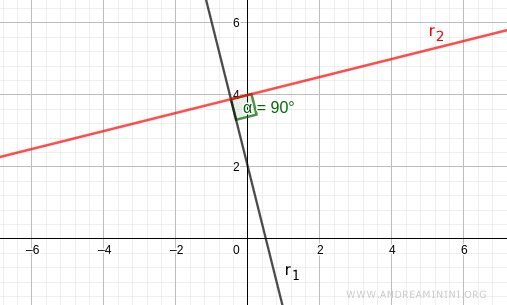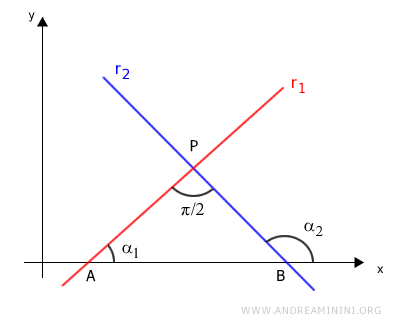Relationship Between the Slopes of Two Perpendicular Lines
When two lines are perpendicular, the slope of one line is the negative reciprocal of the slope of the other: $$ m_1 = - \frac{1}{m_2} $$
Here, m1 represents the slope of one line:
$$ r_1: \ \ y = m_1 \cdot x + q $$
while m2 represents the slope of the other line:
$$ r_2: \ \ y = m_2 \cdot x + q $$
A Practical Example
Let’s take two lines:
$$ r_1 : \ \ y = -4x + 2 $$
$$ r_2 : \ \ y = \frac{1}{4} \cdot x + 4 $$
Notice that the slopes of these lines are indeed negative reciprocals:
$$ m_1 = -4 $$ $$ m_2 = \frac{1}{4} $$
This confirms the perpendicularity condition:
$$ m_1 = - \frac{1}{m_2} $$
Thus, the two lines are perpendicular.
To verify this, I’ll graph them in GeoGebra and measure the angle at their intersection.

The intersection angle between these two lines is indeed a right angle of 90°.
The Proof
Consider two perpendicular lines, r1 and r2, intersecting at point P to form a 90° angle (π/2).

Line r1 intersects the x-axis at point A, creating angle α1, while line r2 intersects it at point B, creating angle α2.
Connecting points A, B, and P forms a right triangle, ABP.
In this triangle, we know the intersection angle is 90° (π/2), along with angle α1.

Angle α2 is an exterior angle and a supplementary angle to the interior angle α2'.
Since the sum of a triangle’s angles is always 180°, the supplementary angle α2 equals the sum of the non-adjacent interior angles:
$$ a_2 = \frac{\pi}{2} + a_1 $$
Applying the tangent function (tan) to both sides, we get:
$$ \tan a_2 = \tan ( \frac{\pi}{2} + a_1 ) $$
Since the associated angle for tangent, tan(180°+x), equals -cot(x):
$$ \tan a_2 = -\cot(a_1) $$
Knowing that cotangent (cot) is the reciprocal of tangent:
$$ \tan a_2 = - \frac{1}{\tan(a_1)} $$
The tangent of angle α2 gives the slope m2 of one line, so tan α2 = m2:
$$ m_2 = - \frac{1}{\tan(a_1)} $$
The tangent of angle α1 gives the slope m1 of the other line, so tan α1 = m1:
$$ m_2 = - \frac{1}{m_2} $$
This completes the proof of the formula we set out to demonstrate.
And so on.
